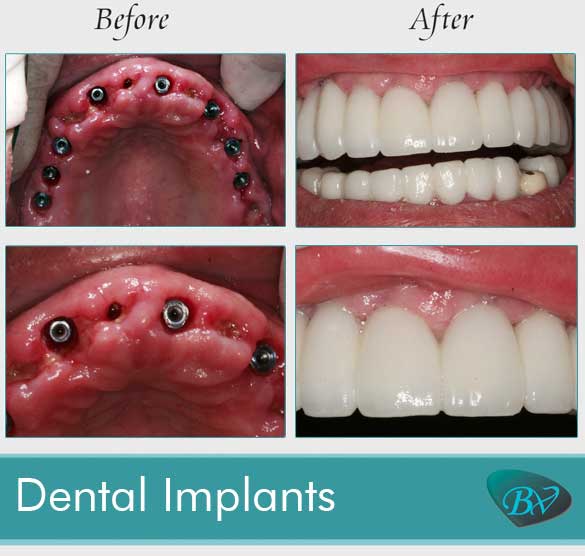All About Dental Sense
All About Dental Sense
Blog Article
See This Report on Dental Sense
Table of Contents5 Simple Techniques For Dental SenseTop Guidelines Of Dental SenseA Biased View of Dental SenseSome Known Incorrect Statements About Dental Sense
are clinical devices surgically dental implanted into the jaw to recover a person's ability to chew or their look. They supply support for artificial (phony) teeth, such as crowns, bridges, or dentures. When a tooth is lost due to injury or condition, an individual can experience issues such as quick bone loss, faulty speech, or changes to chewing patterns that cause pain.Oral implant systems are composed of a dental implant body and dental implant abutment and might also include an abutment fixation screw. Professional teeth whitening. The dental implant body is operatively placed in the jawbone in location of the tooth's root. The dental implant abutment is generally affixed to the implant body by the abutment fixation screw and extends through gums into the mouth to sustain the attached artificial teeth
(https://myspace.com/dentalsense1)Framework of The Dental Implant System picking oral implants, talk to your oral supplier regarding the prospective advantages and threats, and whether you are a candidate for the treatment. Points to think about: Your general wellness is a vital factor in identifying whether you are an excellent prospect for oral implants, how long it will take to heal, and how much time the dental implant might remain in area.
Smoking cigarettes may impact the healing process and lower the long-lasting success of the implant. The recovery process for the dental implant body may take numerous months or longer, throughout which time you normally have a short-lived joint instead of the tooth. the oral implant treatment: Very carefully adhere to the dental health guidelines offered to you by your oral copyright.
Dental Sense Can Be Fun For Anyone
Implant failing can lead to the need for one more surgery to fix or change the implant system. Recovers the capacity to chew Restores aesthetic look Aids keep the jawbone from diminishing due to bone loss Maintains the health of the bordering bone and gum tissues Assists keep surrounding (close-by) teeth stable Boosts high quality of life Damages to surrounding all-natural teeth during dental implant positioning Injury to the surrounding tissues during surgery, such as sinus perforation Injury throughout surgical procedure (as an example, crack of surrounding jawbone) Inadequate function, such as really feeling like the teeth do not bite with each other usually A sensation that the tooth hangs or twisting in position arising from an abutment screw loosening Implant body failure (looseness of the dental implant body) because of systemic infection, which might be most likely in people with unchecked diabetics issues due to regional infection in bone and periodontals sustaining the dental implant body because of postponed recovery, which might be more probable in patients who smoke Problem cleaning up the gum tissues Recommended Site around the dental implant, leading to inadequate oral health Untreated gum condition Post-surgical tingling because of nerve impingement or damage Always inform health and wellness care providers and imaging service technicians that you have oral implants prior to any kind of magnetic vibration imaging (MRI) or x-ray treatments.
FDA is not familiar with any adverse occasions reported for MRI or x-ray procedures with dental implants. Dental implants systems are normally made of materials that comply with worldwide consensus criteria of the International Company for Standardization (ISO) or ASTM International. These requirements have information of what makes a safe material.

An oral implant is a structure that replaces a missing tooth. With screw-like tools, the surgeon inserts an implant into the jawbone, and it serves as an anchor for an artificial tooth, called a crown. A gadget called a joint links the synthetic tooth to the dental implant. The crown is customized to fit the individual's mouth and match the shade of their teeth.
A Biased View of Dental Sense
Some individuals are not qualified for oral implant surgical treatment. It is for dental doctors to run on people with: severe illnessuncontrollable metabolic diseasebone or soft tissue disease or infectionIf these problems are dealt with, an individual can have the surgery. In, dental cosmetic surgeons abstain from operating people with: If individuals with any of the above go through oral implant surgery, there is a higher threat of the dental implant failing.

Oral implant surgical procedure is an individualized procedure. Offer you time to heal. Affix the blog post and last crown, bridge or denture.
Next, your specialist will thoroughly position the dental implant into your jaw. Your cosmetic surgeon will certainly reposition your gum tissues and close the cut with stitches. If your implant is near the front of your mouth, your dental practitioner will certainly make a short-term tooth for you to wear until you recover. By doing this, you won't have a space in your smile while you recuperate.
Not known Factual Statements About Dental Sense
Throughout the healing stage, your jawbone should fuse to the dental implant. This procedure can take anywhere from three to 9 months.
When your dental implant heals, your dentist can affix the abutment (little port post) and your last restoration (crown, bridge or denture). This generally takes regarding one hour to complete and might need a second minor surgical procedure. You should not feel any type of pain throughout your dental implant treatment since your copyright will certainly make use of drug to numb your gum tissues.
Report this page